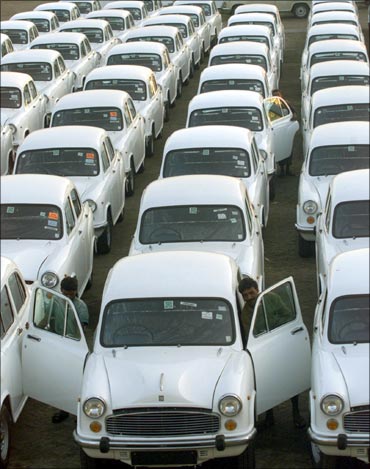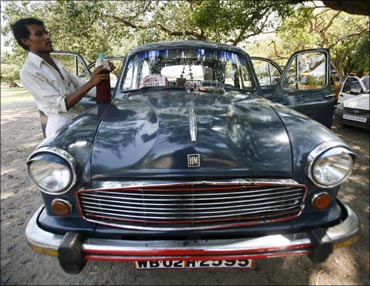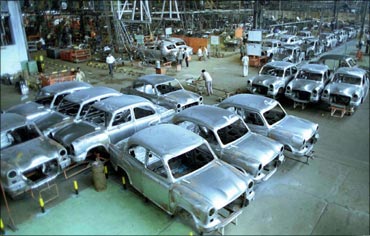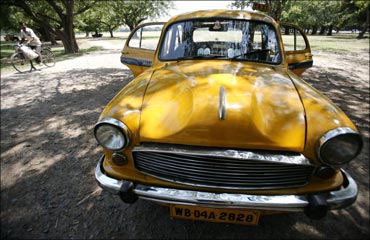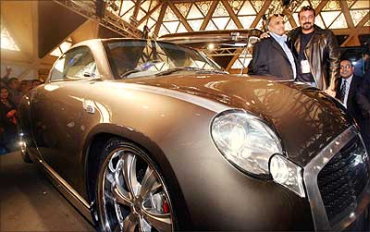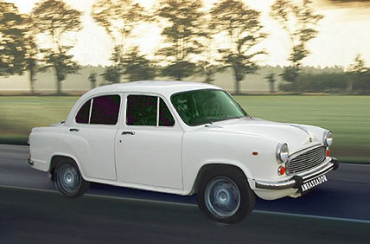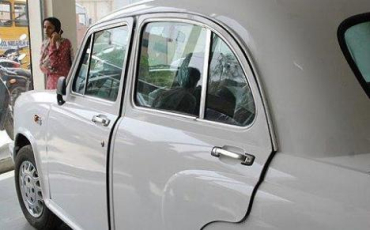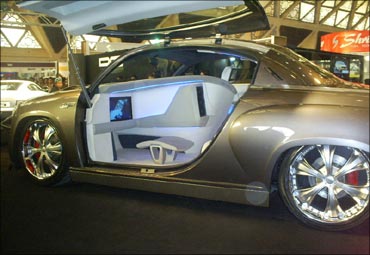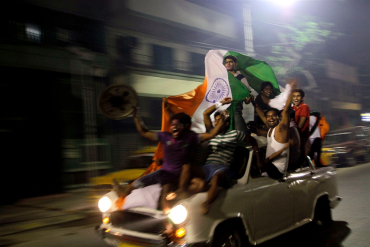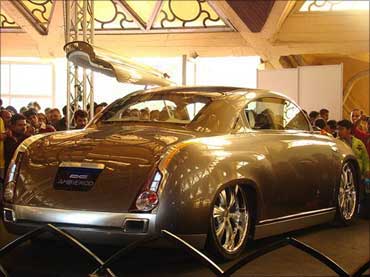 | « Back to article | Print this article |
A rocky road for Hindustan Motors
A dispute over a land sale is not the only problem facing Hindustan Motors.
Declining sales and an inability to meet its capacity have hobbled the car maker.
The fact that CK Birla recently visited Hindustan Motors' Uttarpara facility, located in the Hooghly district of West Bengal, earlier this month after a period of seven years brings up two immediate questions: Shouldn't the head of group that oversees an auto company be far more hands-on with it -- especially, if the firm has been in serious trouble amidst an unprecedented auto boom in the country?
Click NEXT to read further. . .
A rocky road for Hindustan Motors
Moreover, why is the trip making news?
The answer to both these facts perhaps say as much about the health of HM than any analyst report.
Hindustan Motors' Uttarpara plant, the country's oldest automobile factory which produces the Ambassador car, is built on 427 acres of land, out of the total 741 acres it once had in its possession.
The crisis-ridden company approached the state government in 2003 to raise funds by selling the excess 314 acres so it could revive it.
Click NEXT to read further. . .
A rocky road for Hindustan Motors
Since the Uttarpara land had been vested with the West Bengal government, the company needed approval for alternative usage.
The proposal was pending before the state government for more than three years, but finally, in 2006, it got an approval from the Left Front government to sell the land.
HM declared a Rs 85-crore (Rs 850-million) projected revenue for the sale of this excess land.
However, an internal audit done by the state government last November found that HM had sold the land to Bengaluru-based Shriram Properties for the development of an integrated IT township at a price of Rs 285 crore (Rs 2.85 billion) in 2007.
Click NEXT to read further. . .
A rocky road for Hindustan Motors
The state believes that, as the money was not ploughed back into the company, it should be returned to the government as it was the owner of the plot.
Denying the allegation, CK Birla said, "We sold it for Rs 285 crore and we always kept the government informed about that.
"And this Rs 285 crore (Rs 2.85 billion) has entirely been ploughed back to the plant."
However, the state government is not buying the story.
"If the company has utilised the entire fund to revive company, where is the outcome?
Click NEXT to read further. . .
A rocky road for Hindustan Motors
The balance sheet shows the situation has not changed, if not worsened," a government official said.
His reference was to the company's earnings of Rs 47.63 crore (Rs 476.3 million) from selling of land in Gujarat's Halol, which enabled HM to register a net profit of Rs 17.20 crore (Rs 172 million) in the first quarter of the current financial year.
The state government had sought clarification from the company, to which HM has apparently replied.
Since both the parties are being tight-lipped about the issue, whether the clarification has answered government's queries or not can only be judged by what the state does next.
Click NEXT to read further. . .
A rocky road for Hindustan Motors
The company is desperate to move ahead and jettison this controversy, once and for all.
Manoj Jha, managing director of HM, considers CK Birla's visit to Uttarapara as a new beginning.
"He was in the city to attend the annual general meeting. It is great that this time he has managed to visit the plant," said Jha.
"We will honour his commitment of new launches. His visit was a big boost for us," he added.
HM's land fiasco is but a small drama amidst the larger theater of the car maker's struggle to stay relevant in today's India which has become one of the hotspots for carmakers globally.
Click NEXT to read further. . .
A rocky road for Hindustan Motors
The company has a combined annual production capacity of 50,000 units in all three of its plants.
Apart from its iconic Ambassador car manufactured at the Uttarpara plant, HM in technical collaboration of Mitsubishi Corporation of Japan produces passenger cars like the Lancer, Pajero, Cedia, Motero, Outlander and Evo X at its Tiruvallur plant near Chennai.
Variants of its mini truck, Winner, are manufactured both at Uttarpara and its Pithampur facility in Madhya Pradesh.
Birla's company will need more than just a boost from him if it hopes to weather the upcoming years and capitalise on India's hunger for cars.
Click NEXT to read further. . .
A rocky road for Hindustan Motors
As of now, the company's sales are far below its production capacity.
In 2010-11, HM sold 10,097 vehicles compared to 11,003 vehicles in the previous fiscal.
This is chiefly because of poor sales of the Ambassador, which dropped to about 6,600 last financial compared to over 8,000 in the previous year.
Ambassador sales have been hugely affected as diesel engines (1.5 litre and 2.0 litre) of the car are yet to attain BS IV emission norms, which was made mandatory in 13 major cities with effect from April, 2010.
Click NEXT to read further. . .
A rocky road for Hindustan Motors
"Work is on, in collaboration with a European company to develop a euro IV complaint diesel engine which is imperative to revive, sustain and boost sales of Ambassador, Winner and their variants that have been running on the HM plus engine for long. In another two three months time, we are expecting to have it." Jha said.
It is no secret that Amabassador, the oldest face of the Indian automobile industry which was once widely favoured vehicle for both personal and institutional use, has lost its popularity over the years.
Click NEXT to read further. . .
A rocky road for Hindustan Motors
HM now wants to give it a new look to attract new-age customers.
The new Ambassador, likely to be shorter in length with changes in both exterior and interior design, will be unveiled next year.
Moreover, HM is gradually shifting its focus from passenger to commercial segment to drive growth.
It has already launched a 0.8 tonne small commercial vehicle called Veer and two more commercial passenger carriers are in the pipeline from the Uttarpara plant -- one on the Ambassador platform and another on Winner.
Click NEXT to read further. . .
A rocky road for Hindustan Motors
"Our focus is more on the commercial vehicle segment now. The sales ratio of passenger vehicles and commercial vehicles is about 80:20.
"We hope this will be around 50:50 in the next couple of years," Jha said.
The company is also working on a seven seater Otlander and a brand-new sports utility vehicle from its Mitsubishi stable, which will be manufactured at Chennai plant.
Click NEXT to read further. . .
A rocky road for Hindustan Motors
Technically, HM is no longer a 'sick company' under the provisions of Section 23 of Sick Industrial Companies (Special Provisions) Act, 1985 (SICA), as the accumulated losses of the company at the end of last financial year have reduced to less than 50 per cent of its peak net worth during the immediate preceding four financial years.
Still, the beleaguered auto maker has a long road ahead of it.
Though a cautious Birla refused to set a timeline for the revival, Jha expects company's sales to match the production capacity of 50,000 units within a period of three years.
A fulfillment of this promise could help HM to regain its lost glory and perhaps help people forget about its distracting controversies as well.
